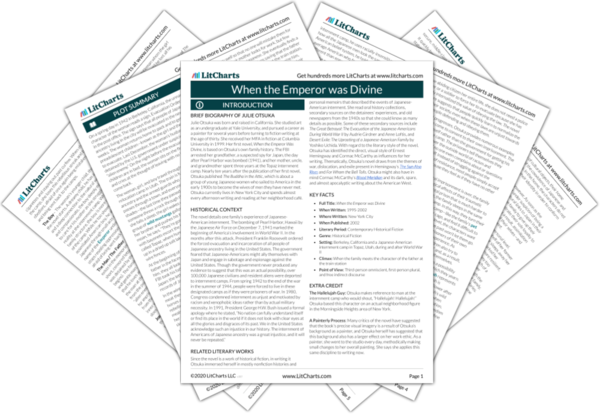Welcome to the LitCharts study guide on Julie Otsuka's When the Emperor was Divine. Created by the original team behind SparkNotes, LitCharts are the world's best literature guides.
Emperor was Divine: Introduction
Emperor was Divine: Plot Summary
Emperor was Divine: Detailed Summary & Analysis
Emperor was Divine: Themes
Emperor was Divine: Quotes
Emperor was Divine: Characters
Emperor was Divine: Symbols
Emperor was Divine: Theme Wheel
Brief Biography of Julie Otsuka

Historical Context of When the Emperor was Divine
Other Books Related to When the Emperor was Divine
- Full Title: When the Emperor was Divine
- When Written: 1995-2002
- Where Written: New York City
- When Published: 2002
- Literary Period: Contemporary Historical Fiction
- Genre: Historical Fiction
- Setting: Berkeley, California and a Japanese-American internment camp in Topaz, Utah, during and after World War II
- Climax: When the family meets the character of the father at the train station
- Point of View: Third-person omniscient, first-person plural, and free indirect discourse
Extra Credit for When the Emperor was Divine
The Hallelujah Guy: Otsuka makes reference to man at the internment camp who would shout, “Hallelujah! Hallelujah!” Otsuka based this character on an actual neighborhood figure in the Morningside Heights area of New York.
A Painterly Process: Many critics of the novel have suggested that the book’s precise visual imagery is a result of Otsuka’s background as a painter, and Otsuka herself has suggested that this background also has a larger effect on her work ethic. As a painter, she went to the studio every day, methodically making small changes to her overall painting. She says she applies this same discipline to writing now.












